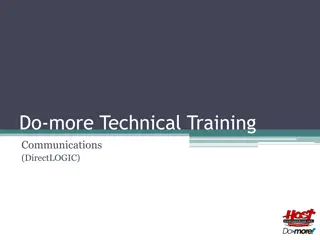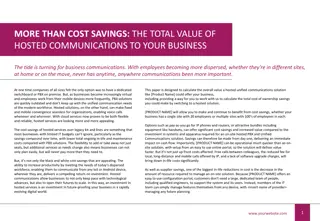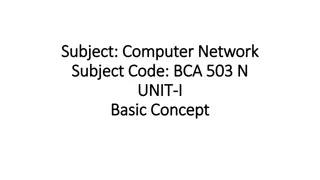Fundamentals of Data Communications: Characteristics and Components
Data communications involve the exchange of data between devices through transmission mediums. The effectiveness of a data communications system relies on key characteristics like delivery, accuracy, timeliness, and jitter. The system components include the message, sender, receiver, transmission medium, and protocol, each playing a vital role in ensuring successful communication.
Download Presentation

Please find below an Image/Link to download the presentation.
The content on the website is provided AS IS for your information and personal use only. It may not be sold, licensed, or shared on other websites without obtaining consent from the author. Download presentation by click this link. If you encounter any issues during the download, it is possible that the publisher has removed the file from their server.
E N D
Presentation Transcript
Data communications CNS-VI
Data communications Data communications are the exchange of data between two devices via some form of transmission medium such as a wire cable For data communications to occur, the communicating devices must be part of a communication system made up of a combination of hardware (physical equipment) and software (programs) . The effectiveness of a data communications system depends on four fundamental characteristics:
Data communications The effectiveness of a data communications system depends on four fundamental characteristics:
Data communications The effectiveness of a data communications system depends on four fundamental characteristics: 1. Delivery . 2. Accuracy. 3. Timeliness . 4. Jitter
Data communications Delivery The system must deliver data to the correct destination. Data must be received by the intended device or user and only by that device or user. Accuracy The system must deliver the data accurately. Data that have been altered in transmission and left uncorrected are unusable. Timeliness The system must deliver data in a timely manner. Data delivered late are useless.
Data communications Jitter Jitter refers to the variation in the packet arrival time. It is the uneven delay in the delivery of audio or video packets.
Data communications A data communications system has five components.
Data communications Message The message is the information (data) to be communicated. Popular forms of information include text, numbers, pictures, audio, and video. Sender The sender is the device that sends the data message. It can be a computer, workstation, telephone handset, video camera, and so on. Receiver The receiver is the device that receives the message. It can be a computer,workstation, telephone handset, television, and so on.
Data communications Transmission medium The transmission medium is the physical path by which a message travels from sender to receiver. Some examples of transmission media include twisted-pair wire, coaxial cable, fiber-optic cable, and radio waves. Protocol A protocol is a set of rules that govern data communications. It represents an agreement between the communicating devices.
Data communications Data transmission modes
Data communications Data transmission modes Communication between two devices can be simplex, half-duplex, or full-duplex. Simplex In simplex mode, the communication is unidirectional, as on a one- way street. Only one of the two devices on a link can transmit; the other can only receive. Keyboards and traditional monitors are examples of simplex devices.
Data communications The keyboard can only introduce input; the monitor can only accept output. The simplex mode can use the entire capacity of the channel to send data in one direction.
Data communications Half-Duplex In half-duplex mode, each station can both transmit and receive, but not at the same time. When one device is sending, the other can only receive, and vice versa. In a half-duplex transmission, the entire capacity of a channel is taken over by whichever of the two devices is transmitting at the time. Walkie-talkies and CB (citizens band) radios are both half-duplex systems.
Data communications The half duplex mode is used in cases where there is no need for communication in both directions at the same time; the entire capacity of the channel can be utilized for each direction.
Data communications Full-Duplex In full-duplex both stations can transmit and receive simultaneously. The full-duplex mode is like a two way street with traffic flowing in both directions at the same time. In full-duplex mode, signals going in one direction share the capacity of the link: with signals going in the other direction. One common example of full-duplex communication is the telephone network .
Data communications Full-Duplex
Data communications Simplex, Half-duplex, or Full-duplex
Data communications Networks A network is a set of devices (often referred to as nodes) connected by communication links. Anode can be a computer, printer, or any other device capable of sending and/or receiving data generated by other nodes on the network. Network Criteria A network must be able to meet a certain number of criteria. The most important of these are performance, reliability, and security
Data communications Performance: Performance can be measured in many ways, including transit time and response time. Reliability: Network reliability is measured by the frequency of failure, the time it takes a link to recover from a failure, and the network's robustness in a catastrophe. Security: Network security issues include protecting data from unauthorized access, protecting data from damage and development, and implementing policies and procedures for recovery from breaches and data losses
Data communications Types of connections: A network is two or more devices connected through links. A link is a communications pathway that transfers data from one device to another. There are two possible types of connections: point-to-point and multipoint .
Data communications Point-to-Point A point-to-point connection provides a dedicated link between two devices. The entire capacity of the link is reserved for transmission between those two devices. Most point-to-point connections use an actual length of wire or cable to connect the two ends, but other options, such as microwave or satellite links, are also possible. When you change television channels by infrared remote control, you are establishing a point-to-point connection between the remote control and the television's control system
Data communications Point-to-Point
Data communications Multipoint A multipoint (also called multidrop) connection is one in which more than two specific devices share a single link. In a multipoint environment, the capacity of the channel is shared, either spatially or temporally. If several devices can use the link simultaneously, it is a spatially sharedconnection. If users must take turns, it is a timeshared connection.
Data communications Multipoint
Data communications Physical topology The term physical topology refers to the way in which a network is laid out physically. One or more devices connect to a link; two or more links form a topology. The topology of a network is the geometric representation of the relationship of all the links and linking devices (usually called nodes) to one another. There are four basic topologies possible: mesh, star, bus, and ring
Data communications BUS Topology Bus topology is a network type in which every computer and network device is connected to single cable. When it has exactly two endpoints, then it is called Linear Bus topology
Data communications Advantages of Bus Topology It is cost effective. Cable required is least compared to other network topology. Used in small networks. It is easy to understand. Easy to expand joining two cables together
Data communications Disadvantages of Bus Topology Cables fails then whole network fails. If network traffic is heavy or nodes are more the performance of the network decreases. Cable has a limited length. It is slower than the ring topology.
Data communications RING Topology In a ring topology, each device has a dedicated point-to-point connection with only the two devices on either side of it. A signal is passed along the ring in one direction, from device to device, until it reaches its destination. Each device in the ring incorporates a repeater. When a device receives a signal intended for another device, its repeater regenerates the bits and passes them along
Data communications RING Topology
Data communications Advantages of Ring Topology Transmitting network is not affected by high traffic or by adding more nodes, as only the nodes having tokens can transmit data. Cheap to install and expand Disadvantages of Ring Topology Troubleshooting is difficult in ring topology. Adding or deleting the computers disturbs the network activity. Failure of one computer disturbs the whole network.
Data communications STAR Topology In a star topology, each device has a dedicated point-to-point link only to central controller, usually called a hub. The devices are not directly linked to one another. Unlike a mesh topology, a star topology does not allow direct traffic between devices The controller acts as an exchange: If one device wants to send data to another, it sends the data to thecontroller, which then relays the data to the other connected device .
Data communications STAR Topology
Data communications Advantages of Star Topology Fast performance with few nodes and low network traffic. Hub can be upgraded easily. Easy to troubleshoot. Easy to setup and modify. Only that node is affected which has failed, rest of the nodes can work smoothly.
Data communications Disadvantages of Star Topology Cost of installation is high. Expensive to use. If the hub fails then the whole network is stopped because all the nodes depend on the hub. Performance is based on the hub that is it depends on its capacity
Data communications MESH Topology It is a point-to-point connection to other nodes or devices. All the network nodes are connected to each other. Mesh has n(n-1)/2 physical channels to link n devices. There are two techniques to transmit data over the Mesh topology, they are :Routing and Flooding
Data communications MESH Topology
Data communications Advantages of Mesh Topology Each connection can carry its own data load. It is robust. Fault is diagnosed easily. Provides security and privacy
Data communications Disadvantages of Mesh Topology Installation and configuration is difficult. Cabling cost is more. Bulk wiring is required.
Data communications Disadvantages of Mesh Topology Installation and configuration is difficult. Cabling cost is more. Bulk wiring is required.
Types of Networks Types of Networks Communication Networks LAN MAN WAN
Types of Networks Types of Networks Local Area Network (LAN) It is also called LAN and designed for small physical areas such as an office, group of buildings or a factory. LANs are used widely as it is easy to design and to troubleshoot. Personal computers and workstations are connected to each other through LANs. We can use different types of topologies through LAN, these are Star, Ring, Bus, Tree etc.
Types of Networks Types of Networks Local Area Network (LAN) LAN can be a simple network like connecting two computers, to share files and network among each other while it can also be as complex as interconnecting an entire building. LAN networks are also widely used to share resources like printers, shared hard-drive etc.
Types of Networks Types of Networks Local Area Network (LAN)
Types of Networks Types of Networks Characteristics of LAN LAN's are private networks, not subject to tariffs or other regulatory controls. LAN's operate at relatively high speed when compared to the typical WAN. There are different types of Media Access Control methods in a LAN, the prominent ones are Ethernet, Token ring. It connects computers in a single building, block or campus, i.e. they work in a restricted geographical area.
Types of Networks Types of Networks Applications of LAN One of the computer in a network can become a server serving all the remaining computers called clients. Software can be stored on the server and it can be used by the remaining clients. Connecting Locally all the workstations in a building to let them communicate with each other locally without any internet access. Sharing common resources like printers etc are some common applications of LAN.
Types of Networks Types of Networks Advantages of LAN Resource Sharing: Computer resources like printers, modems, DVD- ROM drives and hard disks can be shared with the help of local area networks. This reduces cost and hardware purchases. Software Applications Sharing: It is cheaper to use same software over network instead of purchasing separate licensed software for each client a network. Easy and Cheap Communication: Data and messages can easily be transferred over networked computers.
Types of Networks Types of Networks Advantages of LAN Centralized Data: The data of all network users can be saved on hard disk of the server computer. This will help users to use any workstation in a network to access their data. Because data is not stored on workstations locally. Data Security: Since, data is stored on server computer centrally, it will be easy to manage data at only one place and the data will be more secure too. Internet Sharing: Local Area Network provides the facility to share a single internet connection among all the LAN users. In Net Cafes, single internet connection sharing system keeps the internet expenses cheaper.
Types of Networks Types of Networks Disadvantages of LAN High Setup Cost: Although the LAN will save cost over time due to shared computer resources, but the initial setup costs of installing Local Area Networks is high. Privacy Violations: The LAN administrator has the rights to check personal data files of each and every LAN user. Moreover he can check the internet history and computer use history of the LAN user. Data Security Threat: Unauthorized users can access important data of an organization if centralized data repository is not secured properly by the LAN administrator.























